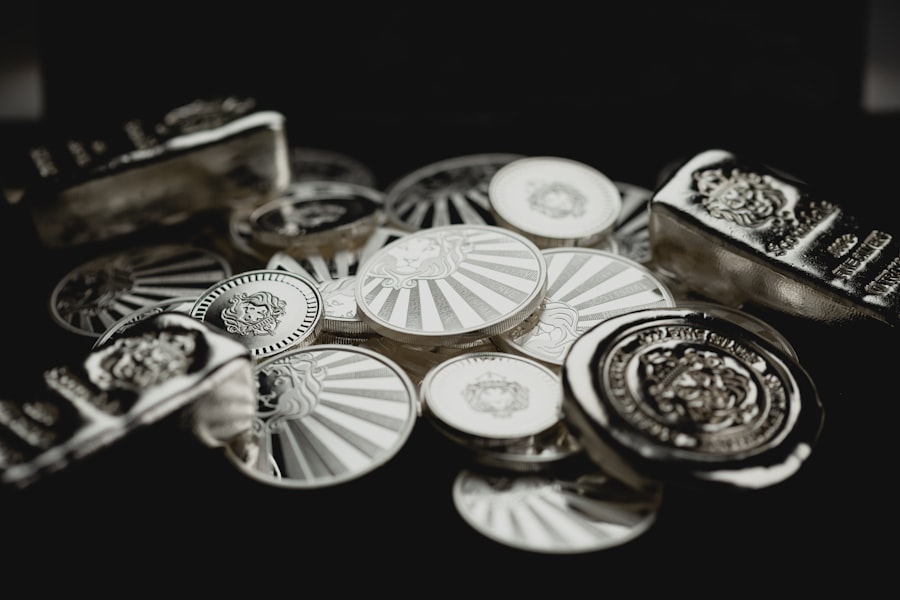In an era marked by economic uncertainty and fluctuating currencies, the allure of physical silver as a safe haven has gained significant traction. You may find yourself questioning the stability of fiat currencies, especially in light of government policies that can lead to inflation or devaluation. Physical silver, unlike digital assets or paper money, offers a tangible form of wealth that has been valued for centuries.
It serves as a hedge against economic turmoil and government interference, providing you with a sense of security in an unpredictable financial landscape. The concept of using physical silver as a safeguard against government actions is rooted in its intrinsic value. Unlike currencies that can be printed at will, silver is a finite resource, making it less susceptible to manipulation.
When you hold physical silver, you possess a form of wealth that is not reliant on the stability of any government or financial institution. This independence from traditional financial systems is what makes silver an attractive option for those looking to protect their assets from potential governmental overreach.
Key Takeaways
- Physical silver is considered a safe haven from government interference due to its intrinsic value and limited supply.
- Historical examples, such as the confiscation of gold by the US government in 1933, highlight the vulnerability of fiat currency and the importance of precious metals as a store of value.
- Including physical silver in a diversified investment portfolio can provide a hedge against inflation and economic uncertainty.
- Advantages of investing in physical silver include its tangible nature and potential for price appreciation, while disadvantages include storage costs and potential for government regulation.
- Government regulation and taxation of physical silver may impact its appeal as a safe haven asset, but it is still considered a reliable option compared to other safe haven assets like gold and cryptocurrencies.
Historical examples of governments interfering with currency and the value of precious metals
Throughout history, there have been numerous instances where governments have intervened in currency systems, leading to significant economic consequences. You might recall the hyperinflation experienced in Germany during the Weimar Republic in the 1920s, where the value of the German mark plummeted, rendering it nearly worthless. In such scenarios, individuals who had invested in precious metals like silver found themselves better insulated from the ravages of inflation.
The tangible nature of silver allowed them to preserve their wealth when fiat currencies failed. Another notable example is the United States’ abandonment of the gold standard in 1971, which effectively severed the link between currency and precious metals. This shift led to increased volatility in the value of the dollar and raised concerns about inflation and government control over monetary policy.
As you consider these historical precedents, it becomes clear that precious metals, including silver, have often served as a refuge during times of economic distress. Their enduring value has made them a reliable store of wealth when fiat currencies falter.
The role of physical silver in a diversified investment portfolio

Incorporating physical silver into your investment portfolio can enhance diversification and reduce overall risk. As you build your financial strategy, it’s essential to recognize that different asset classes respond differently to market conditions. While stocks and bonds may offer growth potential, they are also subject to market volatility and economic downturns.
Physical silver, on the other hand, tends to retain its value during turbulent times, making it a valuable addition to your investment mix. Moreover, silver’s unique properties as both an industrial metal and a precious metal further bolster its appeal. You may find that its demand extends beyond just investment purposes; industries such as electronics, solar energy, and medical technology rely heavily on silver for their manufacturing processes.
This dual demand can provide a level of stability to your investment, as it is not solely dependent on market speculation or investor sentiment. By including physical silver in your portfolio, you position yourself to benefit from both its safe-haven qualities and its industrial applications.
Advantages and disadvantages of investing in physical silver as a safe haven
| Advantages | Disadvantages |
|---|---|
| Historically proven to retain value | Requires storage and security measures |
| Offers protection against inflation | Lack of passive income |
| Liquid and easily tradable | Volatility in market prices |
| Diversification in investment portfolio | Potential for theft or loss |
Investing in physical silver comes with a range of advantages that make it an appealing option for those seeking security from government interference. One significant benefit is its liquidity; you can easily buy or sell silver in various forms, such as coins or bars, depending on your needs. This flexibility allows you to access your investment quickly if necessary.
Additionally, physical silver is not subject to counterparty risk, meaning you do not have to rely on any institution or entity to uphold its value. However, there are also disadvantages to consider when investing in physical silver. One notable drawback is the costs associated with storage and insurance.
Unlike digital assets or stocks held in a brokerage account, physical silver requires secure storage solutions to protect against theft or loss. You may need to invest in a safe or pay for a safety deposit box at a bank, which can add to your overall expenses. Furthermore, while silver can be a hedge against inflation, its price can still be volatile in the short term, influenced by market sentiment and economic conditions.
The potential for government regulation and taxation of physical silver
As you contemplate investing in physical silver as a safe haven, it’s crucial to consider the potential for government regulation and taxation. Governments have historically imposed taxes on precious metals transactions, which can impact your overall returns. For instance, capital gains taxes may apply when you sell your silver for a profit, reducing the financial benefits of your investment.
Additionally, some jurisdictions may implement stricter regulations on the buying and selling of precious metals, which could complicate your ability to liquidate your assets when needed. Moreover, there is always the possibility that governments may enact policies aimed at controlling or restricting ownership of precious metals during times of crisis. While such measures may seem extreme, history has shown that governments can take drastic actions when faced with economic instability.
As you weigh the risks associated with investing in physical silver, it’s essential to stay informed about potential regulatory changes that could affect your investment strategy.
Comparing the safety of physical silver to other safe haven assets such as gold and cryptocurrencies

When considering safe haven assets, it’s natural to compare physical silver with other options like gold and cryptocurrencies. Gold has long been regarded as the ultimate safe haven due to its historical significance and universal acceptance as a store of value. While both gold and silver share similar properties as precious metals, gold typically commands a higher price per ounce and is often viewed as a more stable investment during times of economic uncertainty.
On the other hand, cryptocurrencies have emerged as a modern alternative to traditional safe havens. While they offer potential for high returns and are decentralized from government control, they also come with significant volatility and regulatory scrutiny. As you evaluate these options, it’s essential to consider your risk tolerance and investment goals.
Physical silver provides a tangible asset that can be easily stored and accessed without reliance on technology or digital platforms—an appealing feature for those wary of potential cyber threats or technological failures.
The impact of government policies and economic instability on the value of physical silver
Government policies play a crucial role in shaping the economic landscape and can significantly impact the value of physical silver. For instance, monetary policies that lead to increased money supply or low-interest rates can drive investors toward precious metals as they seek protection from inflation. When you observe central banks engaging in quantitative easing or other expansionary measures, it often results in heightened demand for silver as a hedge against currency devaluation.
Economic instability also influences the value of physical silver. During periods of recession or financial crisis, investors tend to flock to safe-haven assets like silver, driving up demand and prices. Conversely, when economic conditions improve and investor confidence returns, demand for precious metals may wane.
As you navigate these fluctuations in value, it’s essential to stay informed about macroeconomic trends and government policies that could affect your investment in physical silver.
Factors to consider when deciding whether to invest in physical silver as a safe haven
Before committing to an investment in physical silver as a safe haven, there are several factors you should carefully consider.
Understanding your financial goals will help you determine how much of your portfolio should be allocated to physical silver versus other asset classes.
Additionally, consider your risk tolerance and market knowledge. Investing in physical silver requires an understanding of market dynamics and price fluctuations. If you’re new to investing or uncomfortable with market volatility, it may be wise to start with smaller amounts or seek guidance from financial advisors who specialize in precious metals.
Lastly, think about your storage options; ensuring that you have secure methods for storing your physical silver is crucial for protecting your investment.
How to purchase and store physical silver as a safe haven investment
Purchasing physical silver can be done through various channels, including online dealers, local coin shops, or auctions. When selecting a dealer, it’s essential to do thorough research to ensure they are reputable and offer competitive prices. You may want to compare prices across different platforms before making a purchase decision.
Additionally, consider buying recognized bullion coins or bars from established mints; these tend to have higher liquidity and are easier to sell when needed. Once you’ve acquired physical silver, proper storage is paramount for safeguarding your investment. You might choose to keep your silver at home in a secure safe or opt for professional storage solutions offered by banks or specialized vault services.
Each option has its pros and cons; while home storage provides immediate access, professional storage offers enhanced security against theft or loss but may come with additional fees.
Expert opinions and perspectives on the safety of physical silver from government interference
Experts in finance and precious metals often emphasize the importance of diversifying investments with tangible assets like physical silver. Many analysts argue that while no investment is entirely free from risk—including government interference—physical silver remains one of the most reliable options available today. They highlight its historical resilience during economic downturns and its ability to maintain value when fiat currencies falter.
Furthermore, some experts suggest that investing in physical silver can serve as an insurance policy against potential government overreach or economic mismanagement. They argue that having tangible assets allows individuals greater control over their wealth during uncertain times. As you consider expert opinions on this matter, it’s essential to weigh their insights against your own financial goals and risk tolerance.
weighing the risks and benefits of physical silver as a safe haven from government
In conclusion, investing in physical silver as a safe haven from government interference presents both opportunities and challenges that require careful consideration. On one hand, its historical significance as a store of value provides reassurance during times of economic instability; on the other hand, potential regulatory changes could impact its accessibility and profitability. As you navigate this complex landscape, it’s crucial to weigh the risks against the benefits while aligning your investment strategy with your financial goals.
By staying informed about market trends and understanding the unique characteristics of this precious metal, you can make more informed decisions about incorporating it into your investment portfolio as a safeguard against government interference.
In the realm of precious metals, many investors often ponder the safety of their physical silver holdings from potential government intervention. This concern is not unfounded, as history has shown instances where governments have imposed restrictions or confiscated precious metals. For those interested in exploring this topic further, an insightful article on the subject can be found on Real Lore and Order. This piece delves into the historical context and current considerations regarding the security of physical silver investments. To read more about this, you can visit the article on
